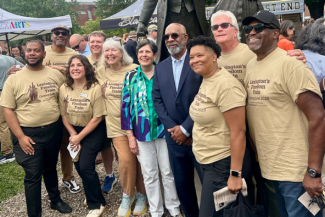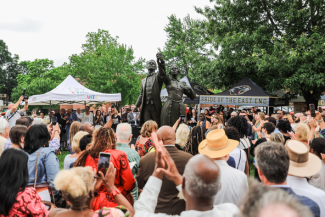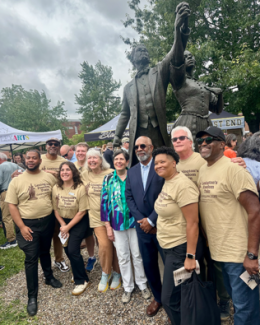When Georgia-based artist Basil Watson submitted his proposal for the Lexington Freedom Train monument, he said he saw an opportunity, not just for creative growth, but to highlight an important story.
“A lot of Black stories have not been told, and I am a part of that community that has been denied the recognition,” he said. “So, this meant another opportunity for me to get involved in telling a Black story. Those are not the only stories to be told, but they are important stories that need to be told now.”
He was there June 19, when the historic monument — a sculpture depicting abolitionists Lewis and Harriet Hayden, who were formerly enslaved in Lexington — was dedicated on North Limestone Street in Lexington.
Titled “Towards Freedom,” the monument honors the Haydens’ legacy. The Haydens were enslaved for 30 years, escaping with their son Joseph in 1844. The monument depicts Lewis and Harriet looking skyward with their clasped hands held high. They are dressed in what historians believe are the clothes in which they escaped and traveled north.
Among the members of the Lexington Freedom Train committee, which selected the artist, are three University of Kentucky faculty members: Vanessa Holden, Ph.D., associate professor of history in the College of Arts and Sciences Department of History; Frank X Walker, a professor in the College of Arts and Sciences Department of English; and Garry Bibbs, a professor of art studio, metal arts and sculpture in the College of Fine Arts School of Art and Visual Studies.
Each faculty member said they were proud of their personal affiliation with the project, but also with their involvement as members of the UK community.
“Having experts from our faculty involved is exactly the kind of community impact that is so important to preserving Kentucky’s history,” said Holden, who is also director of African American and Africana Studies and the Central Kentucky Slavery Initiative. “I see my scholarship as an opportunity to connect with the community in Lexington, and I was excited to lend my expertise to the impressive community group that founded the Freedom Train.”
Walker, former Kentucky Poet Laureate, wrote a poem for the occasion titled “because I am a man” from his book “Load In Nine Times.” The poem’s title is from a direct quote from Lewis Hayden. Walker said UK’s involvement via his membership on the memorial committee, along with Holden and Bibbs, represents a meaningful commitment.
“UK is such an important part of the Lexington community,” Walker said. “It just makes sense that the university would leap at the opportunity to collaborate with the city and state to make this happen and be part of the educational opportunities it will immediately create.”
Renowned as a sculptor himself, Bibbs said with his background, he was honored to be asked to serve on the selection committee.
“I felt my artistic expertise, Black cultural experiences and metal arts and crafts techniques could be put to good use,” Bibbs said. He added that he will use the memorial site as a teaching tool for his own students.
“They’ll be able to experience the art, the history and the story of Lewis and Harriet Hayden,” he said.
From nearly 100 proposals and four finalists, the Lexington Freedom Train selection committee chose Watson, a sculptor from Lawrenceville, Georgia, to create the monument, which stands in Lexington’s historic East End near Lexington Traditional Magnet School.
Watson, born in Kingston, Jamaica, immigrated to the United States in 2002. Prior to his move, he built a successful career as Jamaica’s leading sculptor with works on campuses of the island’s three main universities and two stadiums. In 2016, the Jamaican government awarded him the Order of Distinction (Commander) in recognition of his contributions to the arts. Among his major work on display in the U.S. is “To the World II” in Mirimar, Florida, honoring multiple Olympic gold medalist Usain Bolt; and “Hope Moving Forward” in Atlanta, in honor of the Rev. Martin Luther King Jr. He has several works on display internationally.



